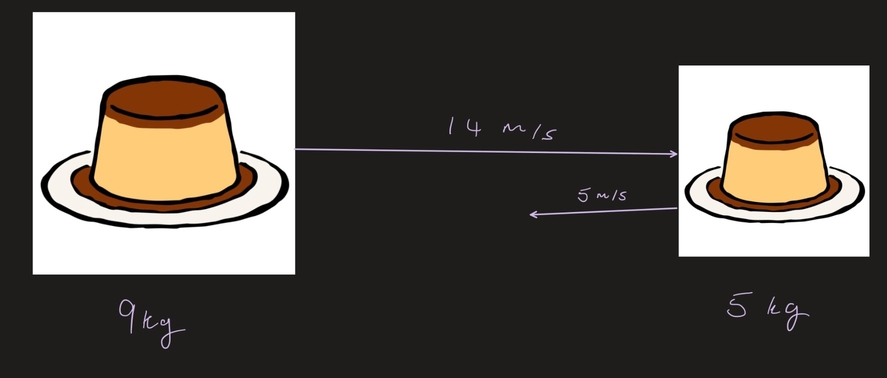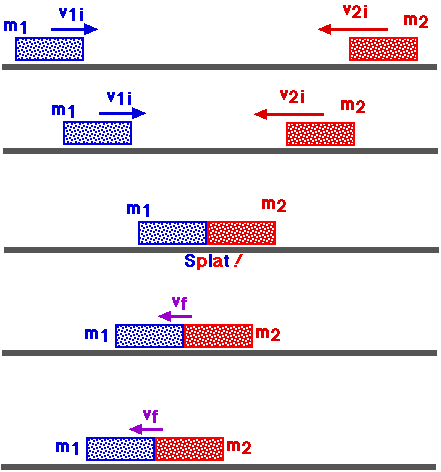Maximally Inelastic Collision
Maximally Inelastic Collisions between multiple objects. claimed by dwinegarden3 (spring 2017) Edited by Alexander Hom (spring 2022) Edited by Suyash Bhardwaj (Fall 2025)
The Main Idea
A collision is a brief interaction between large forces. Collisions can include such phenomena as a ball bouncing off a wall, two people running into each other on their way to class, or atoms bouncing around within a star. There are two primary types of collisions: elastic and inelastic. Elastic collisions occur when the total kinetic energy of the system is conserved while inelastic collisions occur when the objects' kinetic energies are not conserved. Maximally inelastic collisions are a subset of inelastic collisions in which the objects in the system collide and stick together to form one object. The new object has a new velocity and the mass of the object equals the total mass of all the objects that have become one. In terms of the coefficient of restitution, a maximally inelastic collision corresponds to [math]\displaystyle{ e = 0 }[/math], meaning the objects have no relative speed of separation after impact and move together with the same final velocity. An example of a maximally inelastic collision is a car crash or meteor hitting a planet.
Perfectly “sticking” collisions are an idealization; in real materials, whether objects actually stick depends on deformation, bonding, and surface properties, but the maximally inelastic model is a good approximation whenever the objects move together after impact.
A Mathematical Model
Maximally inelastic collisions are first and foremost momentum problems, so modeling such a collision usually begins with the fundamental momentum principle, written in impulse form as
- [math]\displaystyle{ \Delta \vec{p}_{\text{system}} = \vec{F}_{\text{net,ext}}\,\Delta t }[/math]
where \vec{p} is the momentum of the system, \vec{F}_{\text{net,ext}} is the net external force on the system, and Δt is the time interval of the process.
For a collision, we choose the system to be just the colliding objects, and the interaction typically occurs over a very short time. External forces (like gravity or friction) act for such a brief interval that the external impulse is negligible. In that case,
- [math]\displaystyle{ \Delta \vec{p}_{\text{system}} \approx 0 }[/math]
so we can break the change in momentum of the system into its initial and final components to get
- [math]\displaystyle{ \vec{p}_{\text{final}} - \vec{p}_{\text{initial}} \approx 0 }[/math] which becomes
- [math]\displaystyle{ \vec{p}_{\text{final}} \approx \vec{p}_{\text{initial}} }[/math].
If we substitute the mass and velocity of multiple objects into the above equation, we see that:
- [math]\displaystyle{ m_1 v_1 + m_2 v_2 + ... m_n v_n = M V }[/math]
where M is sum of the masses of all collided objects and V is the final velocity of the amalgamated object
- [math]\displaystyle{ V=\frac{\sum {m v}}{M} }[/math]
In maximally inelastic collisions, kinetic energy is not conserved between the initial and final states of the objects.
In more than one spatial dimension, momentum is a vector, so the conservation equation must be applied separately to each component. For example, in two dimensions we have
- [math]\displaystyle{ m_1 v_{1x} + m_2 v_{2x} + \dots + m_n v_{nx} = M V_x }[/math]
- [math]\displaystyle{ m_1 v_{1y} + m_2 v_{2y} + \dots + m_n v_{ny} = M V_y }[/math]
and similarly for three-dimensional collisions.
In maximally inelastic collisions, kinetic energy is not conserved between the initial and final states of the objects. However, total energy is conserved. This is possible because some of the energy is lost to heat and changes in shape, accounted for in the change of internal energy called ΔU. Thus, we can use the energy principle:
- [math]\displaystyle{ {E} = {Q} + {W} }[/math] where E is the total energy of the system, Q is the change in thermal energy, and W is the work done.
If we input the various types of energy; such as kinetic, potential, and internal; in for the total energy, we get
- [math]\displaystyle{ {ΔE_k}+{ΔE_p}+{ΔU}= {Q} + {W} }[/math] where [math]\displaystyle{ ΔE_k }[/math] is the change in kinetic energy of the system,[math]\displaystyle{ ΔE_p }[/math] is the change in the potential energy of the system, and [math]\displaystyle{ ΔU }[/math] is the change in internal energy.
Since we assume that the objects all end up as one combined object with no significant loss of mass, we can also assume that the work done on the system by the surroundings during the short collision is negligible, and that any change in potential energy over this brief interval is negligible. The collision itself can generate significant internal (thermal and deformation) energy within the objects, but because the interaction is so rapid we typically neglect any heat exchanged with the surroundings. With these assumptions in place, the equation above simplifies to
- [math]\displaystyle{ {ΔE_k} + {ΔU} = 0 }[/math] which we can break into the initial and final components to get
- [math]\displaystyle{ {ΔU} = -({K_{final}} - ({K_{initial,1}} + {K_{initial,2}} +... {K_{initial,n}})) }[/math]
Kinetic Energy for objects that have a velocity significantly smaller than the speed of light is defined as [math]\displaystyle{ \frac{1}{2}{mv^2} }[/math], so putting in the values for mass and velocity we get that:
- [math]\displaystyle{ \Delta U = \left(\frac{1}{2} m_1 v_1^2 + \frac{1}{2} m_2 v_2^2 + \dots + \frac{1}{2} m_n v_n^2\right) - \frac{1}{2} M V^2 }[/math]
However, when the kinetic energy of an object is close to the speed of light, relativistic equations are required. In this case, the kinetic energy is equal instead to
- [math]\displaystyle{ {K} = \frac{mc^2}{\sqrt{1-(\frac{v}{c})^2}} - mc^2 }[/math]
where m is the mass of the object, V is the velocity of the object, c is the speed of light (~3e8 m/s). The first element on the left of the above equation accounts for all of the energy of an object and the second element removes the rest energy of the system from the total energy, leaving the relativistic kinetic energy. Relativistic expressions are only necessary when the speed [math]\displaystyle{ v }[/math] is a significant fraction of the speed of light (typically [math]\displaystyle{ v \gtrsim 0.1c }[/math]); for most introductory collision problems, the classical expression [math]\displaystyle{ \tfrac{1}{2}mv^2 }[/math] is entirely sufficient. When this is put into the overall equation with the known values, we get
- [math]\displaystyle{ {ΔU} = (\frac{Mc^2}{\sqrt{1-(\frac{V}{c})^2}} - Mc^2) - (\sum_{n=1}^N \frac{m_N c^2}{\sqrt{1-(\frac{v_N}{c})^2}} - m_N c^2) }[/math]
A Computational Model
Maximally Inelastic Collisions using Glowscript
Examples
Simple
Problem
Greco wants to eat a very large flan, but Fenton and Gumbart both have small flans, so they decide to combine the flans. Fenton throws a 9 kg mass flan at a velocity of 14 m/s which strikes Gumbart's flan that weighs 5 kg mass with a velocity of -5 m/s head-on, and the two flans stick together to make an ultra mega flan for Greco to eat. At what speed will the giant flan have? Greco can only catch objects that are flying at 5 m/s, will he catch it or will it go past him? Assume negligible air resistance.
Hint
Solution
Use conservation of momentum to solve for the final velocity : [math]\displaystyle{ m_1 v_1 + m_2 v_2 = \left( m_1 + m_2 \right) v \, }[/math]. Solving for the final velocity we get the equation: [math]\displaystyle{ v=\frac{m_1 v_1 + m_2 v_2}{m_1 + m_2} }[/math]. Plugging in the numbers yields us a final velocity of 7.214 m/s, therefore Greco will be unable to catch the flan.
Middling
Problem
A .1 kg bullet is launched at 100 m/s a stationary block that weighs 5kg. The bullet embeds itself into the block. When someone goes to retrieve the bullet and remove it from the block, they notice the block is slightly warmer than it was before. By how much did the block's thermal energy change? The specific heat of the block and bullet is 6 J/(g*C) so by how many degrees did the block warm up by?
Solution Using the conservation of momentum principle, we can find the final velocity of the object: [math]\displaystyle{ m_1 v_1 = \left( m_1 + m_2 \right) v \, }[/math] which is 1.961 m/s. Now we can use the conservation of Energy principle to solve for the thermal energy: [math]\displaystyle{ {ΔE_k} + {ΔU} = 0. }[/math] Then we break the change of kinetic energy into it's initial and final conditions to get : [math]\displaystyle{ {ΔU} = -({K_{final}} - ({K_{initial,bullet}})) }[/math] Plugging in the values we get : [math]\displaystyle{ {ΔU} = \frac{1}{2}{(v_{final})^2}{(m_{final})} - (\frac{1}{2}{m_{bullet} (v_{bullet})^2}) }[/math]. Entering the values from the word problem, our final answer is 490J.
To find the change in temperature, we need to use the heat equation : [math]\displaystyle{ Q = mCΔT }[/math] Plugging in the given information of specific heat, thermal energy that we solved for, and the mass of the final object, we get an increase of 16 degrees.
Difficult
Problem
Sally (5 years old) is at the playground and decides that she wants to go on the ride that spins really fast in circles. The playground ride consists of a currently stationary disk of mass M = 45 kg and radius R = 2.4 m mounted on a low-friction axle. Sally weighs about 18 kg. She is super excited to play and runs at speed of 2.3 m/s on a line tangential to the disk and jumps onto the outer edge of the disk. She initially decided to just run around and spin the wheel, but later she decides that she wants to jump on and let the wheel keep going. What is the change of energy of the system?
Solution
This problem is difficult because it requires the use of the three big equations of classical physics 1. First we need to use the conservation of angular momentum and calculate the initial angular momentum which is [math]\displaystyle{ L = RPsinθ }[/math]. In this case, the momentum is 60 [math]\displaystyle{ m^2 kg/s }[/math]. Next we need to find the angular velocity of the ride with Sally. Using the equation: [math]\displaystyle{ L_i = Iω + RPsinθ }[/math] where we can use the relationship that [math]\displaystyle{ v = ωr }[/math] to find the more useful equation : [math]\displaystyle{ L_i = Iω + RmwR }[/math]. Since this is a wheel, the moment of inertia will be [math]\displaystyle{ .5MR^2 }[/math]. Solving for ω gives us .639 radians.
Now we can solve for the change in energies using the formula : [math]\displaystyle{ {ΔE_k} + {ΔU} = 0 }[/math]. However, in this case we need to break the kinetic energies into rotational and translational and then their respective final and initial parts. So we get the rather large equation : [math]\displaystyle{ K_{rot,f} + K_{trans,f} + ΔU = K_{rot,i} + K_{trans,i} }[/math] where we can convert [math]\displaystyle{ K_{rot} }[/math] to [math]\displaystyle{ .5Iω^2 }[/math]. Using the conservation of linear momentum theorem, we can find Sally's final velocity with the equation : [math]\displaystyle{ v=\frac{m_1 v_1 + m_2 v_2}{m_1 + m_2} }[/math]. Plugging in values, we find that her final velocity is 1.02m/s. Now we can plug all our numbers into the previous equation and solve for the change in energy, which is 373J.
Connectedness
This topic is of interest to me as I am very interested in astronomy and a very important Maximally Inelastic Collision in space is the collision of asteroids. Because asteroids usually stick together after a collision, their collisions can be modeled with the equations of Maximally Inelastic Collisions. Maximally Inelastic Collisions are also important to NASA, where I want to work; NASA is planning to use the Asteroid Redirect Mission, or the ARM program, in order to keep asteroids from hitting the Earth and must use the Maximally Inelastic Collision equations in order to plot the path of the asteroids after collision to ensure that they do not hit the Earth in their new flight path. Most other celestial collisions are generally modeled as inelastic collisions because they stick together. When two stars collide they absorb each other and form one star, when they don't explode. Because this forms one massive sphere with evenly distributed mass, this collision is an almost ideal Maximally Inelastic Collision.
History
The idea of maximally inelastic collisions is part of the conservation of linear momentum which is implied by Newton's Laws. Most objects tend to bounce off each other, creating the idea of collision. Most objects that are visibly colliding tend to lose energy through a variety of ways, but theoretically objects could collide and not lose kinetic energy. This created the two types of collisions: inelastic and elastic. Elastic defines collisions that have no change in kinetic energy; these are usually microscopic, such as Rutherford Scattering. All other collisions tend to be inelastic since some energy is lost between the objects, and so their kinetic energies change. However, some objects can stick together and therefore combine their masses. This is a special case of inelastic collisions and tend to be a small portion of collisions that actually occur in real life, but some examples seen are when cars collide or when a sticky substance stays on an object it is throw at.
See also
There are several other topics within this wiki that can give you more information on collisions as a whole, including Inelastic Collisions and Elastic Collisions. These topics, along with the basic fundamentals such as Kinetic Energy and Newton's Second Law: the Momentum Principle that we used to derive the equations, will give some context for maximally inelastic collisions in classical physics.
Further reading
These extensive resources cover this topic in more depth
- A physics resource written by experts for an expert audience Physics Portal
- A wiki book on modern physics Modern Physics Wiki
- The MIT open courseware for intro physics MITOCW Wiki
- An online concept map of intro physics HyperPhysics
- Interactive physics simulations PhET
- OpenStax algebra based intro physics textbook College Physics
- The Open Source Physics project is a collection of online physics resources OSP
- A resource guide compiled by the AAPT for educators ComPADRE
External links
These are some internet articles that can show more animations and pictures to help understand this concept
References
The primary reference I used was the textbook : Matter and Interactions 4th edition. Full Citation: Chabay, Ruth W., and Bruce A. Sherwood. Matter and Interactions. Hoboken, NJ: Wiley, 2011. Print.
http://www.kshitij-iitjee.com/Study/Physics/Part1/Chapter9/33.jpg



